Positive Health Online
Your Country

Selecting the Ideal Running Shoe - from Injury-Free Running
by Thomas Michaud DC(more info)
listed in exercise and fitness, originally published in issue 262 - May 2020
Injury-Free Running
Published by Lotus Publishing. 2014; Distribution 2019. Paperback. £14.99 / $15.69. ISBN 1467589314. New edition due November 2020 Injury-Free Running, Your Illustrated Guide to Biomechanics, Gait Analysis, and Injury Prevention, 2nd Edition ISBN 978-1-913088-16-3.
Available from Lotus Publishing, Amazon.co.uk and Amazon.com
Given the potential for lacerations, abrasions, and/or thermal injury, it seems odd that for almost all of our seven-million-year history as bipeds, we got around the planet barefoot. Although we perceive our feet as being delicate structures in need of protection, when barefoot from birth, the human foot is remarkably resilient. In a study comparing lifelong shod feet with the feet of people who have never worn shoes, researchers from Belgium confirm that the unshod forefoot is 16% wider than the shod forefoot.[1] The increased width allows for improved distribution of pressure while walking and running. In their analysis of pressure centred beneath the forefoot in lifelong shod versus unshod individuals, the authors confirm that regular shoe use is associated with significantly more pressure being centred directly beneath the middle of the forefoot. When barefoot from birth, your toes become so strong that they push down with more force, distributing pressure away from the center of the forefoot towards the tips of the toes. This is consistent with an analysis of skeletal remains dating back 100,000 years, confirming that people who are barefoot from birth get less forefoot arthritis because their strong toes distribute pressure more effectively.[2]
Remember, the fat pads beneath our feet contains 4.5 times the amount of polyunsaturated fat as conventional fat, and the reduced viscosity associated with greater amounts of polyunsaturated fats insulates our soft tissues from even sub-zero temperatures. Ever wonder why only the skin on the bottom of your hands and feet wrinkle when you get out of a bath or shower? Neurobiologists from a research lab in Idaho[3] claim these wrinkles act like treads on a tire to improve our ability to grasp wet surfaces.
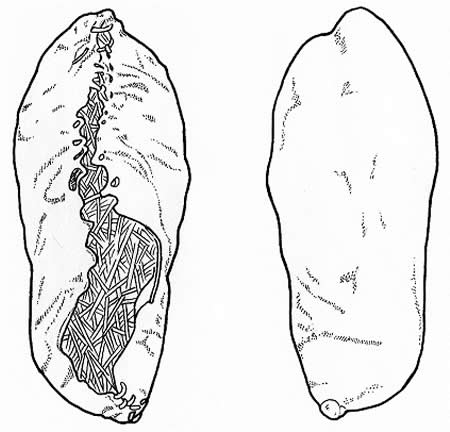
Fig. 5.1. The earliest shoes resembled stitched leather bags.
The First Evidence of Shoe Use
Although Neanderthals were suspected of occasionally using insulated foot coverings, the first direct evidence of shoe use dates back to only 3,500 years ago (Fig. 5.1). To get around the fact that ancient shoes rapidly decayed leaving no evidence of use, Trinkaus and Shang[4] decided to date the initiation of shoe wear by searching for changes in the shapes of the toes of our early ancestors. Because regular shoe use lessens strain on the toe muscles, the authors theorized that habitual shoe use would be associated with the sudden appearance of a thinning of the proximal phalanges (the bones at the base of our toes).
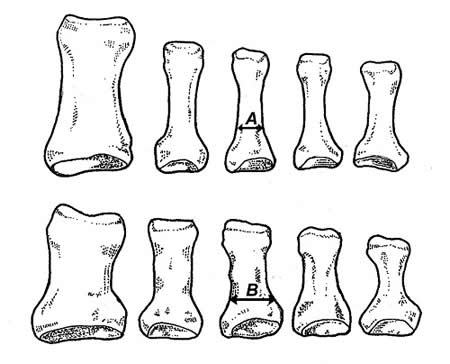
Fig. 5.2. Compare the width of the toe bones from the early (bottom row) and late (top row) Pleistocene era. Trinkaus and Shang[3] claim that the decreased strain on the toes associated with regular shoe use produced bony remodelling with a gradual narrowing of the toe bones (compare A and B).
By precisely measuring all aspects of toe shape and composition, the authors discovered a marked decrease in the robusticity of the toe bones during the late Pleistocene era, approximately 30,000 years ago (Fig. 5.2). Because there was no change in overall limb robusticity, the anatomical inference is that shoe gear eventually resulted in the development of narrower toes. The authors state that because there is no evidence of a meaningful reduction in biomechanical loads placed on human lower limbs during the late Pleistocene era (e.g., reduced foraging distances), the logical conclusion is that the thinner toes could only have only resulted from the use of shoes.
Athletic Shoes from the Early 1900s
Leather continued to be the most popular material used for making shoe gear until the late 1800s, when Charles Goodyear accidentally dropped rubber into heated sulphur creating vulcanized rubber. Prior to his serendipitous discovery, rubber was a relatively useless material because it melted at relatively low temperatures. The newfound resiliency of this material would have numerous applications, including the production of the first athletic shoe. Although alternate names for the new foot wear include tennis shoes, trainers and runners, the term sneaker became the most popular, and its origin can be traced back to an 1887 quote from The Boston Journal of Education:[5] “It is only the harassed schoolmaster who can fully appreciate the pertinence of the name boys give to tennis shoes – sneakers.” Apparently, the soft rubber soles allowed schoolchildren to sneak up quietly on unsuspecting teachers.
Spalding manufactured one of the earliest athletic shoes: The Converse All-Star. Used by athletes at Springfield College to play the newly invented game of basketball, the All-Star was immediately popular. Since their introduction in 1908, more than 70 million pairs of Converse have been sold worldwide. In 1916, the US Rubber Company introduced Keds, an athletic shoe made with a flexible rubber bottom and canvas upper comparable to the Converse All-Star. The first orthopaedic athletic shoe was developed by New Balance shortly before the Great Depression. New Balance continues to be the world’s largest manufacturer of athletic shoes made with different widths. The German shoemaker Adi Dassler formed Adidas in the 1930s, while his brother Rudi formed Puma in the 1940s. Adidas was the more popular company and was the dominant manufacturer of sneakers until the 1960s, when Phil Knight and Bill Bowerman created Blue Ribbon Sports. Renamed Nike Inc. in 1978, after the Greek goddess of victory, this company has remained the world’s largest producer of athletic shoes and sporting apparel for more than 50 years.
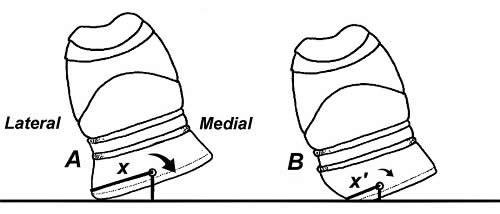
Fig. 5.3. The first running shoes were made with large lateral flares (A), which provided ground-reactive forces with a longer lever arm (X) for pronating the rear foot at heel strike. This feature produces significant increases in the initial range and velocity of pronation. Note that a midsole with a negative flare (B) provides ground-reactive forces with a shorter lever arm (X’) for pronating the rear foot.
Running Shoes from the 1970s through 2010
The design of the first sneaker manufactured specifically for running was simple: a thin rubber sole was covered with a canvas upper, providing nominal cushioning and protection. The next generation of running shoes were built with thicker midsoles possessing large medial and lateral heel flares designed to improve stability. Unfortunately, the lateral heel flares were quickly proven to increase the potential for injury as they provided the ground with a longer lever for pronating the rear foot during heel strike[6] (Fig. 5.3). While this research was published in the late 80s by one of the top biomechanists in the world, shoe manufactures were slow to respond and continued to include lateral flares for years to come.
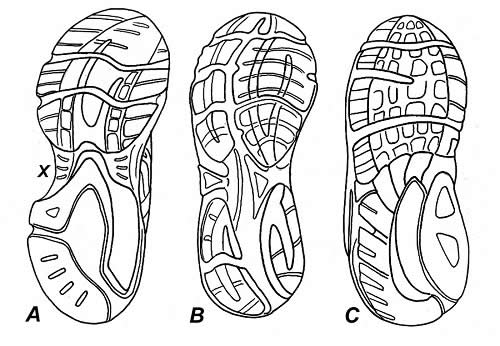
Fig. 5.4. Bottom view of the 3 types of running shoes. Cushion running shoes (A) are made for individuals with high arches. They are slightly curved to match the shape of the typical high-arched foot and possess flexible midsoles with significantly less bulk in the midfoot region (X). The reduced midsole material in the midfoot gives the shoe an hourglass appearance when viewed from below. Stability sneakers (B) are made for individuals with neutral foot types. They are straighter and have slightly more midsole material reinforced beneath the arch. In contrast, motion control sneakers (C) are very straight and are strongly reinforced throughout the midfoot with extra-thick midsole material. Because of the additional midsole material, motion control sneakers are extremely stiff.
The main factor that changed from the flimsy running shoes of the 1960s, was that manufacturers began to build sneakers to fit runners with one of three different arch heights: cushion sneakers for runners with high arches, stability sneakers for neutral-arched runners, and motion control sneakers for flat-footed over-pronators (Fig. 5.4). The vast majority of midsoles were made of polyurethane (PU) or Ethylene vinyl acetate (EVA). Polyurethane is the most resilient of these materials, because it provides maximum resistance against compression without breaking down.
The density of the different midsole materials varies considerably and this was useful when designing sneakers for runners with high and low arches. High-arched runners wore the least dense midsoles to improve shock absorption, while over pronators usually received a blend of midsole materials with soft material incorporated into the lateral midsole and firm material used along the medial midsole. Referred to as a dual-density midsole, the softer material on the outer side softens impact forces and decreases the initial velocity of pronation, while the firmer material on the inner side provides protection against excessive pronation.[7] The dual-density midsole essentially creates a functional rear foot varus post that lessens the amount of rear foot pronation following heel strike.
Despite providing cushioning and motion control, one main drawback to the early thick midsoles was their weight. Because a running shoe is located so far from your hip, it has a very long lever arm to your hip muscles, forcing these muscles to work harder to accelerate and decelerate the added weight. It’s comparable to sitting on a seesaw when the person on the other side suddenly moves farther back: because the person’s body weight suddenly has a longer lever arm to the pivot of the seesaw, you get stuck in the air. In regards to running, every 100 grams (3.5 ounces) of midsole material you add to a running shoe increases the metabolic cost of running by one percent. Known as the “1% rule,” the increased exertion associated with accelerating and decelerating a heavy midsole can be extremely fatiguing when worn over the course of a marathon.
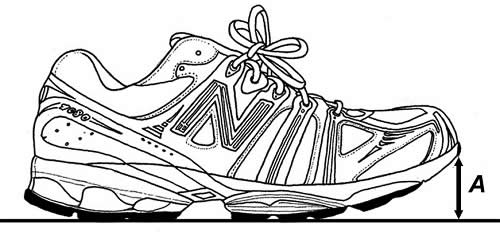
Fig. 5.5. The typical running shoe is manufactured with a toe spring (A) that allows the foot to move in a more natural manner and reduces strain on the Achilles and plantar fascia.
Until recently, the heels of running shoes were almost universally elevated with an additional 10-12 mm of midsole material to support and protect the heel from impact forces. Unlike the flat Converse All-Star and Keds, the forward portions of the early midsoles were also modified by adding different degrees of toe-spring (Fig. 5.5). This modification, which represents a superior angulation of the far end of the midsole, effectively shortens the functional length of the shoe while also allowing the toes to move through reduced ranges of motion during propulsion. This midsole design is invaluable in the treatment of Achilles tendinitis, plantar fasciitis, metatarsal stress syndrome, and/ or bunion pain as it allows to the foot to go through push off with a rolling action.
Compared to the flimsy sneakers of the 1960s, running shoe manufacturers were positive that specifically designing running shoes to match the biomechanical needs of runners with different arch heights would not only reduce the risk of injury, but also improve performance. Some argue the long-term use of excessive toe springs would result in weakness of the intrinsic muscles of the arch.
In 2010, several quality studies evaluated whether or not the prescription of running shoes based on arch height had merit. In one of the largest studies done to date, Knapik et al.[8] divided 1,400 male and female Marine Corps recruits into two groups: an experimental group in which running shoe recommendation was based on arch height, and a control group that wore neutral stability running shoes regardless of arch height. After completing an intensive 12-week training regimen, the authors concluded that prescribing running shoes according to arch height was not necessary, since there was no difference in injury rates between the two groups.
In another study evaluating the value of prescribing running shoes according to arch height, Ryan et al.[9] categorized 81 female runners as supinators, neutral, or pronators, and then randomly assigned them to wear neutral, stability, or motion control running shoes. Again, the authors concluded that there was no correlation between foot type, running shoe use, and the frequency of reported pain. One of the more interesting findings of this research was that the individuals classified as pronators reported greater levels of pain when wearing the motion control running shoes, which didn’t surprise me as these shoes are often as stiff as rocks.
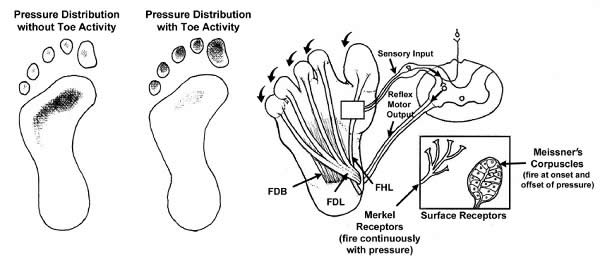
Fig. 5.6. When stimulated, skin receptors located beneath the first metatarsal head produce a reflex contraction of the toe muscles, which transfers pressure away from the central forefoot, to the tips of the toes. This protective reflex text our forefeet from injury. FDB: flexor digitorum brevis; FDL: flexor digitorum longus; FHL: flexor hallucis longus.
Problems Associated with Too Much Midsole Material
Throughout the 80s and 90s, researchers from Canada questioned the belief that cushioning the foot by adding more midsole material would protect against injury.[10,11] They claimed that highly cushioned running shoes might increase the potential for injury as people are unable to feel the ground properly. To prove this, they poked small metal balls into different spots along the bottom of the foot and determined the skin beneath the first metatarsal head is nearly 10 times more sensitive to pressure than skin beneath the heel. The increased sensation beneath the first met allows sensory receptors to produce reflex contraction of the toe muscles when these receptors are stimulated while walking and running. As the toes push down to offload the sensitive first metatarsal head, they distribute pressure over a broader area effectively negating the heavy loads centred beneath the metatarsal heads (Fig. 5.6). This research explains why over 100,000 years ago, our ancestors rarely developed arthritis in the joints of their forefeet, while we regularly get severe arthritis and bunions in those joints now.
In 1997, Robbins and Waked[10] did a simple test to evaluate the effect soft materials have on our ability to respond to impact. They measured impact forces as healthy subjects stepped off a perch onto a platform 4.5 cm below. The platform was made from either 0,1,2, or 3 inches of the EVA foam. Paradoxically, subjects landing on the thickest foams had the highest impact forces. The authors claim that because soft surfaces make it difficult to feel the ground properly, subjects hit the softer surface harder by reducing knee and hip flexion so they can compress the foam and thereby feel the surface better. They reference an interesting study showing that gymnasts landing on soft 4-inch thick mats generate 20% more impact force than when they land on a hard floor.[13] The only problem with this research is that the subjects were landing on 30-90 mm of EVA foam, which at the time was way more foam than you could fit into a running shoe.
Problems Associated with Too Little Midsole Material
Given the fact that excessive midsole cushioning can increase impact force and reduce efficiency (remember the 1% rule), it might seem that the best midsole would be no midsole at all. While this is often suggested by advocates of barefoot running, the complete removal of a midsole may result in chronic injury because some degree of midsole cushioning is necessary to protect the heel and forefoot fat pads from trauma. Researchers from the Netherlands have proven that barefoot running results in a 60% deformation of the protective fat pad beneath the heel, while running with running shoes with conventional midsoles results in only a 35% deformation of the fat pad.[14] When repeated tens of thousands of times over your running career, the 60% deformation may permanently damage the walls of your protective fat pads, resulting in chronic heel and/or forefoot pain.
In addition to extending the lifespan of your heel pads, research proves the softer running shoe midsoles are capable of storing and returning energy, offsetting the reduced efficiency associated with its added weight. By studying oxygen consumption while runners ran either barefoot or with running shoes having 10-millimeter-thick midsoles, researchers from the University of Colorado prove that despite the added midsole weight associated with wearing running shoes, there is no difference in efficiency when running barefoot or with cushioned midsoles. [15]
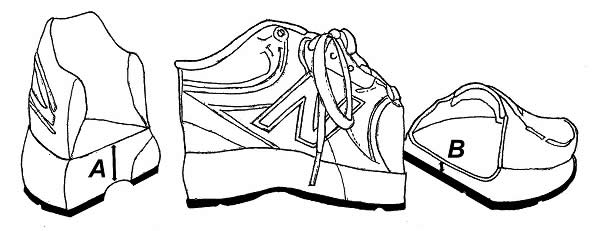
Fig. 5.7. The heel-toe drop. The heel-to-toe differential refers to the difference in midsole thickness beneath the heel (A) and forefoot (B). This particular sneaker has 22 mm of midsole material beneath the heel, and 11 mm of midsole material beneath the forefoot, creating a 10 mm heel-toe drop.
Changing the Midsole’s Heel-to-Toe Drop
As mentioned, throughout the 80s, 90s and early 2000s, all running shoes were made with a 10-12 mm heel-to-toe drop (Fig. 5.7). This degree of heel elevation was considered essential to offload the Achilles tendon and absorb impact force when the heel hit the ground. In an attempt to reduce weight and more closely duplicate the way the foot moves when barefoot, different manufacturers began to gradually reduce the amount of midsole material beneath the heel. Zero-drop running shoes were eventually introduced with the same amount of cushioning in the forefoot and rear foot and are often considered ‘more natural’ as they allow your foot to function as if you were barefoot. Proponents of zero-drop shoes claim the excessive cushioning associated with the high heel-to-toe drop running sneakers cause you to strike the ground with a more pronounced heel strike, which also results in lower knee flexion angles at touch down, as well as less ankle dorsiflexion during midstance.[16] Advocates of running shoes with 12 mm heel-to-toe drop claim the added cushioning in the heel provides comfort and protects them from injuries.
To resolve the controversy regarding heel-toe drop, researchers from France had 553 runners wear running shoes manufactured with 0, 6, or 10 mm of heel-to-toe elevation.[17] The sneakers, which were identical except for the degree of heel elevation, were randomly prescribed and the runners were followed for 6 months. The fact that the shoes were identical except for heel elevation is what makes this paper significant: because there are so many differences between different models of running shoes, it’s impossible to evaluate the effect of one factor without controlling all other factors. Prior studies evaluating the effect of heel height can’t be sure their outcomes were actually the result of the heel-to-toe drop or some other attribute of the shoe. At the end of the 6-month study, while there was no overall difference in injury rates, the 0 and 6-mm drop running shoes were associated with a lower risk of injury in occasional runners, while experienced runners wearing the 10 mm heel-to-toe drop shoes were less likely to be injured. While this was just one study, it fits with what I’ve observed in practice in that faster high mileage runners prefer sneakers with 10 to 12 mm of heel-toe drop, while slower recreational runners do well with 0- and 6-mm heel-toe drop models. As with midsole stiffness and weight, the heel-toe differential is an important factor associated with improved comfort and you should experiment with different models until you find the midsole height that feels best to you.
Running Shoes From 2010 to Present
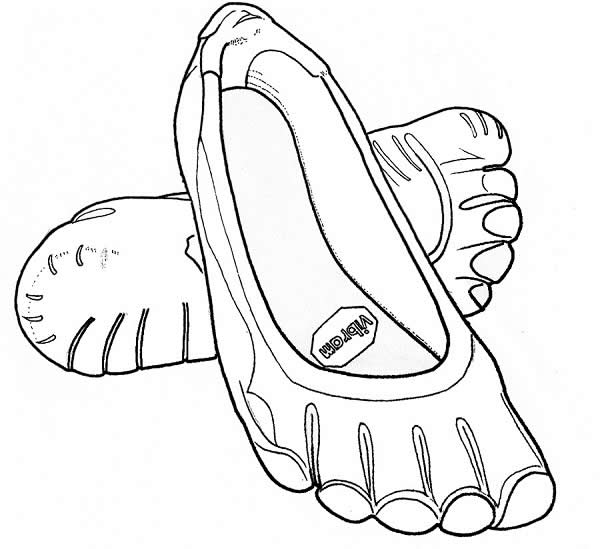
Fig. 5.8. The Vibram 5-finger running shoe is designed to mimic barefoot activity.
Minimalist Running Shoes
Inspired in part by the popular book Born To Run by Christopher McDougal, minimalist running shoes were initially designed to mimic barefoot running (Fig. 5.8). According to the paleoanthropologist Daniel Lieberman, to protect their heels from injury, barefoot runners naturally switch to a more forward contact point, which theoretically improves the storage and return of energy and more effectively dampens impact forces.[18]
While the possibility of improved energy return and dampened impact forces sounds appealing, it is necessary that runners wearing minimalist shoes actually switch to the more forward contact point in order to obtain these benefits. Unfortunately, this is not always the case. In a study of runners transitioning to minimalist shoe wear, 35% of the runners continued to make ground contact with their heels in spite of wearing the minimalist shoes for more than two years.[19] Although runners with midfoot strike patterns may benefit from minimalist shoes, slow runners who continue to strike the ground with their heels are more likely to be injured, since vertical loading rates beneath the heel are nearly 40% higher when rear foot striking with a minimalist shoe.[20] Furthermore, research showing that a 10-millimeter thick midsole does not reduce efficiency because it improves the storage and return of energy suggests that even fast runners can afford the protection provided by conventional midsoles.[15]
Another problem with minimalist shoe wear is that you are more likely to be injured while breaking them in. In a frequently cited study published in Medicine and Science in Sports and Exercise, researchers from Brigham Young University noted that 10 out of 19 runners transitioning into minimalist shoes became injured, compared to only one out of 17 runners in the control group wearing conventional running shoes.[21] In my experience, runners with narrow forefeet and tight calves are especially injury prone while wearing minimalist shoes. Remember, our barefoot ancestors had robust toes and forefeet that were 16% wider than ours, so managing propulsive period forces without protection was less of a problem. An important consideration is that the average Homo erectus that started the whole Born to Run movement was 5’2’’ tall and weighed about 110 pounds, so it’s not surprising that recent research shows that heavier male runners are so frequently injured while wearing minimalist shoes.[22]
In the most detailed studies of minimalist shoes to date, researchers from Australia[23] evaluated the short- and long-term effects of wearing minimalist shoes as runners gradually transitioned from 0-100% minimalist shoe use for their daily runs. For the first 6-weeks of the study, the authors had 50 recreationally competitive male runners gradually transition into wearing minimalist shoes for 35% of their total weekly running mileage. All runners were habitual rear foot strikers and had been accustomed to conventional running shoes. After the 6-week break-in, runners were instructed to continue transitioning into the minimalist shoes by increasing allocated use by 5% each week for an additional 20 weeks. At the 6- and 20-week mark, researchers measured running performance, running economy, calf strength, lower limb bone mineral density, stride length, and cadence.
By week 6 of the study, runners transitioning into minimalist showed slight improvements in running economy and performance, which the authors attributed to the reduced weight of the minimalist shoes. Two of the 50 runners switched from a heel to a forefoot contact point during the first 6 weeks. When the study finally concluded after 20 weeks, regular use of minimalist running shoes was shown to have absolutely no effect on performance, running economy, stride length, cadence, bone mineral density, or even point of initial contact (the 2 runners who transitioned to a forefoot contact reverted back to their typical rear foot strike by week 20). Significantly, the minimalist shoes did slightly increase ankle plantar flexor strength, which was consistent with prior research demonstrating 8 weeks of running in minimalist shoes increased intrinsic foot muscle cross-sectional area.[24] The authors state that because of the limited benefits associated with using minimalist shoes for 100% of their training, runners “may need to consider limiting minimalist shoe use to lower percentages of total training volume because greater minimalist shoe volume has been previously associated with increased injury risk.”
My takeaway from this study is that when worn throughout the day while walking and/or for brief periods of slow running, minimalist shoes favourably stimulate muscles of the arch and calves without overloading them, often resulting in significant increases is strength and volume of the muscles of the arch and legs.[24] Over time, this may result in not just strength gains, but an improved ability to store and return energy in the muscles and tendons of the arch and leg. This statement is supported by the fact that compared to runners wearing conventional running shoes, experienced maximalist runners have larger and more resilient Achilles tendons.[25] Increases in muscle strength and tendon resiliency can have long-term benefits, especially in master’s runners, who slow down as they age not because of decreased force output in their hips or knees, but because their calves weaken as they age.[26]
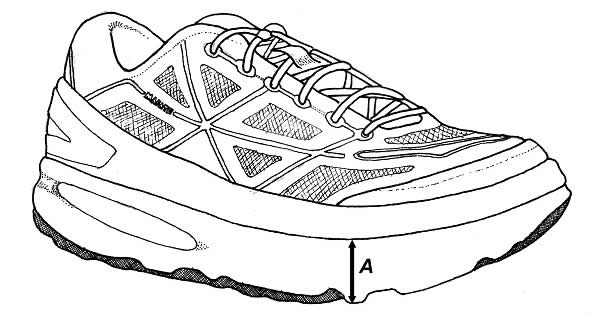
Fig. 5.9. The Hoka One One can have as much as 37 mm of midsole cushioning (A).
Maximalist Running Shoes
At about the time the popularity of minimalist shoes began to fade (in part due to the high injury rates), an obscure French company named Hoka One One came out with the first maximalist running shoe: the Mafate (Fig. 5.9). The company name originates from the Maori language meaning “to fly over earth” and the One One portion of the name is pronounced Oh-nay On-nay. The earliest Hoka models were specifically designed to help runners manage the extreme impact forces associated with fast downhill running by stacking huge amounts of midsole material into the shoe. Because these shoes are so thick, the term “stack height” was developed to refer to the total amount of shoe material between the foot and the ground. It’s usually expressed with 2 numbers: the first stack height number is the thickness beneath the heel, and the second is the thickness beneath the forefoot. Compared to zero-drop minimalist shoes with a stack height of 12/12 mm, it is not uncommon for maximalist shoes to have stack heights of well over 30 mm. The Hoka One One Bondi has a stack height of 37mm/33mm.
Immediately popular with the ultra-running community, maximalist shoes have been catching on with recreational runners. Other running shoe manufacturers have noticed the success of the maximalist shoes and companies like Altra, Vasque, New Balance, Brooks and Adidas have developed their own models, each with its own unique shapes, stack heights and heel-to-toe drops.
Because of the excessive midsole material, you would think the maximalist shoes would increase impact forces according to the original research published by Robbins and Waked as discussed previously. In fact, initial research suggested that wearing maximalist shoes did indeed increase impact force. In 2018 researchers from Oregon State University compared vertical ground reactive forces between the Hoka One One and a traditional New Balance running shoe.[27] Consistent with prior research on the paradox relationship between midsole thickness and impact force, the subjects wearing the Hoka One One had significantly higher impact forces and loading rates compared to the conventional running shoes. The results of this study were in agreement with one study[28] but conflicted with another.[29] The problem with all of these studies is that researchers compared completely different running shoes, which have too many different features to make a judgement about stack height alone.
In 2020, to determine the effect of stack height by itself, researchers from San Jose State University performed a detailed study comparing ground reactive forces and 3-dimensional motions as 20 recreational runners ran with 3 different types of running shoes: maximalist, traditional, and minimalist shoes.[30] Unlike prior studies, these researchers used the same running shoe in each category (New Balance Boracay), they just varied the stack height for each shoe: the maximal shoe was created with 33 mm rear foot and 29 mm of forefoot cushioning, the neutral had 22 mm rear foot and 18 mm forefoot, while the minimalist shoes were created with 10 mm of rear foot and 6 mm the forefoot cushioning. Other than thickness of the midsoles, the shoes were all identical.
After analyzing three-dimensional motion and impact forces associated with the different shoes, the authors determined that while the loading rate was significantly higher in the minimalist shoe, no other differences were seen for ground reactive force variables. Importantly, runners wearing the maximal shoe had significantly greater rear foot eversion (pronation) present during the push off phase of gait. The increased rear foot eversion is a significant finding as excessive pronation of the heel has been linked to a wide range of injuries,[31] especially medial tibial stress syndrome.[32] The authors finish their paper by stating that more research is needed on the effect of maximal running shoes, as “the limited research to date is not in agreement.” Nonetheless, many of the maximalist models are gaining popularity not just with runners but in professions such as nursing, where foot pain is the number 1 cause of occupational injury.
New Categories: Fast, Soft, or Stable
Given the new changes in structure and function of the latest running shoes, the old categories of cushion, stability, and motion control are no longer adequate to classify all the new models. To that end, many experts now categorize running shoes as either fast, soft, or stable. Keeping with the 1% rule, fast models are lighter and typically possess slightly lower heel drops than the other models. The stable shoes tend to weigh just slightly more than soft models, but often possess reinforcement struts and/or plates embedded in their midsoles to provide support.
In the soft models, Salomon worked with Dow Chemicals to create the Sonic 3 Balance, which contains one layer of a memory-like foam to absorb shock and another layer that is light and responsive. Another popular soft model is the Asics Nimbus. In addition to its special gel lining that wraps its heel, the Gel-Nimbus 22 has a layer of lightweight FlyteFoam Lyte placed on top of a full layer of FlyteFoam Propel, a high-rebound elastomer to provide extra spring during push off. The New Balance Fresh Foam X 1080 was just voted Editors’ Choice among soft running shoes by Runner’s World. What I like about this model is that the Fresh Foam midsole has a moulded heel made with a deep pocket that wraps around the back of the foot to eliminate unwanted movement. In my opinion, a well-fitting heel counter is one of the most important things to look for when choosing a running shoe. Another popular soft running shoe is the Adidas Adi Zero Boost. The midsole of this shoe is made with Adiprene, a proprietary blend of urethane polymers cured with special chemicals to enhance strength and resilience. This unique foam retains the ability to absorb shock even at subfreezing temperatures. Adiprene is highly effective at storing and returning energy, which is why these shoes are so frequently worn by the world’s fastest runners.
Unlike the heavy motion control shoes of the past, several of the new stability models come in weighing less than 10 ounces. The Nike React Infinity Run Flyknit weighs only 9.6 ounces and is designed with a wide forefoot, a flared midsole and a slight ramp beneath the midfoot, which is designed to “give your foot proprioceptive cues.” Another stability shoe, the Mizuno Wave Inspire Waveknit, has special reinforcement plates embedded in the midsole near the inside of the medial arch. These plates provide additional support should your foot roll in too much. The stability New Balance 860 has kept its varus posts to control motion but reduced the ramp angle to make it feel smoother. In contrast, Brooks Adrenaline scrapped the rear foot post all together in favour of more subtle changes to the shape of the midsole.
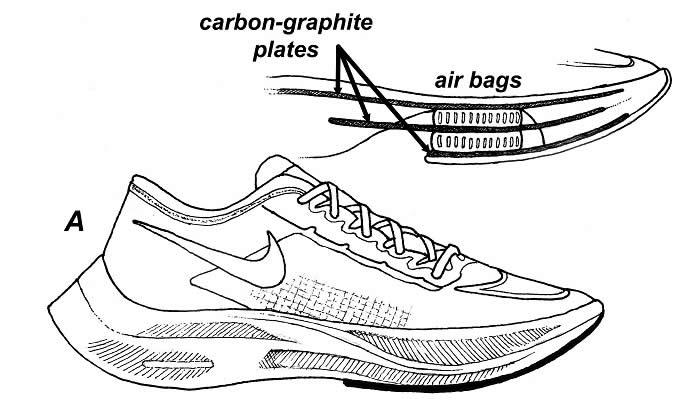
Fig. 5.10. The Nike Vaporfly (A) has a graphite plate embedded in the forefoot between 2 layers of Pebax foam. The Nike Air ZoomX Alphafly Net% (top) has 3 carbon graphite plates (arrows) with 4 separate air bags located beneath the forefoot (2 on each side).
When it comes to fast running shoes, the hands down winner is the Nike Air ZoomX Alphafly Net% (who names these things?). Eliud Kipchoge made history wearing these shoes by being the first person to run 26.2 miles in under 2 hours. Nike boasts that regardless of skill level, the Alphaflys and their predecessor the Vaporflys can improve economy by as much as 4%, which translates into a 3.4% increase in speed for the world’s fastest marathon runners, and a 4% improvement in speed for 3-hour marathon runners.[33] In addition to weighing less than 7 ounces, the Alphaflys have special air chambers located beneath the forefoot (called airpods) and a graphite plate has been embedded in the midsole that can store and return energy during propulsion (Fig. 5.10). What really makes these shoes so fast is the new Pebax midsole, which is uncommonly compliant and resilient. In a 2017 study published in Sports Medicine, Wouter Hoogkamer and his colleagues[33] had 18 high-calibre runners complete a series of 5-minute running trials wearing one of three shoes: the Nike Zoom Streak 6 (midsole lightweight EVA with a rear foot airbag and a 23/15 stack height), the Adidas Adizero Adios Boost 2 (TPU midsole with a 23/13 stack), and the Nike Vaporfly ZoomX (Peba midsole with an embedded carbon plate and a 31/21 stack height). After equalizing the weights by adding lead pellets to the lighter shoes, the examiners measured oxygen consumption and CO2 production as the elite runners ran at different speeds on different days. At the end of the study, subjects wearing the Vaporflys lowered their metabolic cost of running by a shocking 4%. Even more impressive, this 4% improvement occurred at every running speed on every day of the study. The only drawback was that athletes wearing the Nike Vaporflys had slight increases in their stride lengths and impact forces, which could translate into a greater prevalence of hamstring and/or knee injuries.
While the carbon plate may have played a slight role in the improved economy, it more than likely was the Pebax midsole, which has just the right blend of stiffness and energy return. The authors claim that to improve performance, a midsole must have high compliance (the ability to deform) and high resilience (the ability to return energy). They use the example of running on a sandy beach: the sand is compliant so you sink into it, but it’s not resilient, so you have to work hard to push forward. Like a springy indoor track, Pebax midsoles come close to that perfect blend of compliance and resilience. The high compliance makes it so you don’t have to flex your knees and hips to absorb shock, while the resilience offloads your arch muscles by returning free energy. Whatever the mechanism, these shoes represent the most innovative changes in shoe production since Goodyear discovered rubber. Critics of the new technologies claim they provide an unfair advantage and as of February 2020, the World Athletics decided to ban shoes containing more than one rigid embedded plate or blade and/or any shoe that had a sole height greater than 40 mm.
An important point about these running shoes that no one has discussed is that all of the tests to date have been done on elite athletes. The ability of a midsole to store and return energy is dependent upon the ability of the midsole material (or air pods) to compress just the right amount so the stored energy can be returned. The midsole compliance and resilience that works for a 130-pound elite male running at a 4:30 min/mile pace would probably not work that well for a heavier and slower recreational runner. In regards to running, the midsole/air pods would also have to be adjusted depending upon running speed, which affects forces beneath the foot. Nike claims the pressure and size of the airpods will someday be adjustable in order to maximize individual performance, but I doubt that will be an affordable option for most recreational runners. In my opinion, rather than looking to footwear to improve your ability to store and return energy, you'd be better off doing specific exercises and drills to enhance tendon resiliency. In the 2017 paper evaluating the Vaporflys, Dr Hoogkamer and his colleagues state “regardless of the shoes worn, in human running, the vast majority of the mechanical energy storage and return occurs within our natural biological structures.” To me, that sentence speaks volumes.
Selecting the Running Shoe That’s Right for You
Assuming you don’t have a company like Nike bending over backwards to design the perfect running shoe for your particular mechanics, given all the different companies and models out there, it can be a bit overwhelming trying to find the running shoe that’s right for you. Some experts continue to claim you should pick a shoe based on your arch height, while others recommend you should pick a shoe based on how much pronation you may or may not have. To resolve the controversy, Dr Nigg looked at the relationship between running shoe prescription and running injuries and determined that when runners self-select running shoes based on comfort alone, they are much less likely to be injured.[34] Dr Nigg also proved that self-selected comfortable running shoes improve efficiency by reducing oxygen consumption. Apparently, you may not have to spend $250 on a pair of Vaporflys to get slight improvements in efficiency. The only problem with Dr Nigg's research is that it only included studies up to 2014. According to the latest research, high-mileage recreational runners should avoid 0 drop shoes and stick to running shoes with a minimum of 8 mm heel elevation, while low-mileage runners would probably do better with a 0 to 6 mm heel drop sneaker.[17] Because they increase rear foot pronation during contact,[30] beginner runners should avoid maximalist shoes unless the fit is perfect and they feel really comfortable. That being the case, then by all means buy them but take your time breaking them in. You could also consider doing some pre-emptive tibialis posterior exercises to reduce the rate of rear foot pronation associated with using maximalist shoes. I’ve also noticed that unlike the motion control models from the 80s and 90s, runners who pronated excessively prefer stability shoes while high arched runners prefer soft shoes. Early motion control models like the Brooks Beast have been replaced with more comfortable, flexible models that can decelerate the velocity of pronation and provide support without bulk. Softer models have been proven to decrease impact forces, which is why high arched runners find them so comfortable.
If you’re a serious runner and you’re looking to get that extra 4% associated with the Nike Vaporflys, consider reducing your stride length for the first few weeks you’re breaking them in. Remember, Hoogkamer and his colleagues[33] showed that Vaporflys produced slight increases in impact forces and stride lengths, which could increase the risk of a hamstring injury. Because hamstring strains have over a 70% annual re-injury rate, the slight improvement in performance would be meaningless if you’re unable to run. As with rear foot eversion and maximalist shoes, your hamstrings should quickly adapt to the slight increase in stride length associated with wearing the Vaporflys. You could also do pre-emptive eccentric hamstring exercises to prevent injury.
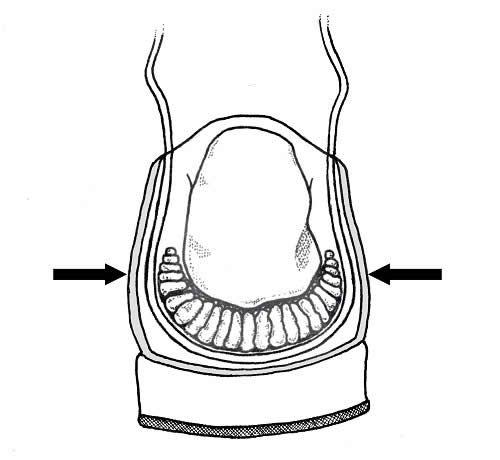
Fig. 5.11. A firm heel counter (arrows) compresses the sides of the rear foot, preventing the calcaneal fat pad from displacing from beneath the bottom of the foot. No synthetic material comes close to matching the shock absorbing capabilities of the human fat pad.
Because the most important predictor of comfort is that the shoe fits your foot perfectly, you should know how to check length, width, and fit of the heel counter. To check length, make sure you’re fitting the running shoe to your larger foot (everyone has slight differences between right and left shoe size) and when standing, the tip of your longest toe should be about the width of your thumbnail from the end of the shoe. Selecting the proper shoe width, both in the forefoot and rear foot, is essential. The widest part of the forefoot of the shoe should match the location of your metatarsal head. As mentioned previously, you should always look for a running shoe that cradles your heel firmly (Fig. 5.11). In a paper published more than 30 years ago, Jorgenson[35] proved that a snug heel counter has the ability to reduce impact forces at foot strike, decrease activity in the quadriceps and calf musculature during stance, and improve overall efficiency.[34] The impressive outcomes in this study can be traced directly to the fact that a snug heel counter prevents displacement of the calcaneal fat pad, which has been proven to absorb shock better than any synthetic material. Although Pebax didn’t exist at the time, I’m sure that if a head-to-head comparison between the calcaneal fat pad and Pebax were performed today, your fat pad would win hands down. The bottom line when it comes to purchasing a running shoe, rather than listening to an expert on running shoes tell you what shoe is right for you, trust your own judgment. Apparently, just as runners intuitively know how to self-select their ideal stride length while running, they also know how to self-select the ideal running shoe.
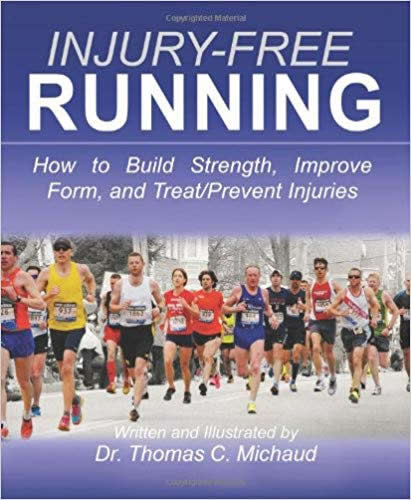
References
1. D’Aout K, Pataky T, DeClerq D, Aerts P. The effects of habitual footwear use: foot shape and function in native barefoot walkers. Footwear Science;1(2):81–94. 2009.
2. Zipfel B, Berger L. Shod versus unshod: the emergence of forefoot pathology in modern humans? Foot;17:205-213. 2007.
3. Changizi m, Weber R, Kotecha R et al. Are wet-induced wrinkled fingers primate rain treads? Brain Behav Evol 77:286–290. 2011.
4. Trinkaus E, Shang H. Anatomical evidence for the antiquity of human footwear: Tianyuan and Sunghir. J Archeol Sci 35:1928-1933. 2008.
5. Crisp Sayings. New York Times, September 2, 1887.
6. Nigg B, Morlock M. The influence of lateral heel flare of running shoes on pronation and impact forces. Med Sci Sports Exerc 1987;19:294.5. Nike 10-K, Item 6, page 21. 2009.
7. Frederick EC. The running shoe: dilemmas and dichotomies in design. In: Segesser B, Pforringer W (eds). The Shoe in Sport. Chicago:Yearbook MedicalPublishers:31. 1989.
8. Knapik J, Trone D, Swedler D, et al. Injury reduction effectiveness of assigning running shoes based on plantar shaped in Marine Corps basic training. Am J Sports Med;38:1759-1767. 2010.
9. Ryan M, Valiant G, McDonald K, Taunton J. The effect of three different levels of footwear stability on pain outcomes in women runners: a randomized control trial. Br J Sports Med, published online 27 June 2010.
10. Robbins S, Waked E. Balance and vertical impact in sport: role of shoe sole materials. Arch Phys Med Rehab;78. 1997.
11. Robbins S, Hanna A. Running-related injury prevention through barefoot adaptation. Med Sci Sports Exerc;Vol.19:148-156. 1987.
13. Mennit-Gray J, Yokoi T. The influence of surface characteristics on the impulse characteristics of drop landings. In: Proceedings of the 13th annual meeting of the American Society of Biomechanics. Burlington (VT): American Society of Biomechanics; 92–3. 1989.
14. DeClercq D, Aerts P, Kunnen M. The mechanical behavior characteristics of the human heel pad during foot strike in running: an in vivo cineradiographic study. J Biomech;27:1213–1222. 1994.
15. Tung K, Franz J, Kram R. A test of the metabolic cost of cushioning hypothesis in barefoot and shod running. American Society of Biomechanics Annual Meeting. Gainesville, FL. August 2012.
16. Chambon N, Delattre N, Gueguen N, Berton E, Rao G. Shoe drop has opposite influence on running pattern when running overground or on a treadmill. Eur J Appl Physiol 115(5):911-918. 2015.
17. Malisoux L. et al. Influence of the heel-to-toe drop of standard cushion running shoes on injury risk in leisure-time runners: a randomized controlled trial with 6-month follow-up. Am J Sports Med; 44:2933. 2016.
18. Lieberman D, Venkadesan M, Werbel W, et al. Foot strike patterns and collision forces in habitually barefoot versus shod runners. Nature 2010;463: 28 Jan 2010.
19. McCarthy C, et al. Like barefoot, only better. ACE Certified News;:8-12. September 2011
20. Goss D, Lewek M, Yu B, Gross M. Accuracy of self-reported foot strike patterns and loading rates associated with traditional and minimalist running shoes. American Society of Biomechanics Annual Meeting. Gainesville, FL. August 2012.
21. Ridge S, Johnson A, Mitchell U, et al. Foot bone marrow edema after 10-week transition to minimalist running shoes. Med Sci Sports & Exerc 2013.
22. Fuller G., Thewlis J, Buckley D, et al. Body mass and weekly training distance influence the pain and injuries experienced by runners using minimalist shoes: A randomized controlled trial. Am J Sports Med; 45:1162–1170. 2017.
23. Fuller J, Thewlis D, Tsiris M, et al. Longer-term effects of minimalist shoes on running performance, stride in bone density: A 20-week follow-up study. Europ J Sport Sci;19:402–412. 2019.
24. Ridge S, Olsen M, Bruening D, et al. Walking in minimalist shoes is effective for strengthening foot muscles. Med Sci Exerc 2018:104-113. 2018.
25. Histen K, Arntsen J, L’Hereux L, et al. Achilles tendon properties of minimalist and traditionally shod runners. J Sport Rehab 26:159–164. 2017.
26. Paquette M, DeVita P, Williams D. Biomechanical implications of training volume and intensity in aging runners. Med Sci Sports Exerc. October 9 2017.
27. Pollard C, Ter Har J, Hannigan J et al. Influence of maximal running shoes on biomechanics before and after a 5K run. Orthop J Sports Med 2018; 6:1-5. 2018.
28. Kulmala J-P, Kosonen J, Nurminen J et al. Running in highly cushioned shoes increases leg stiffness and amplifies impact loading. Sci Rep; 8(1):1–7.2018.
29. Hannigan JJ, Pollard CD. A 6-week transition to maximal running shoes does not change running biomechanics. Am J Sports Med; 47(4):968–973. 2019.
30. Hannigan Jay, Pollard C. Differences in running biomechanics between a maximal, traditional, and minimal running shoe. J Sc Med Sp; 23:15-19. 2019.
31. Kuhman DJ, Paquette MR, Peel SA et al. Comparison of ankle kinematics and ground reaction forces between prospectively injured and uninjured collegiate cross-country runners. Hum Mov Sci; 47:9–15. 2016.
32. Becker J, Nakajima M, Wu WFW. Factors contributing to medial tibial stress syndrome in runners: a prospective study. Med Sci Sports Exerc; 50(10):2092–2100. 2018.
33. Hoogkamer W, Kipp S, Farina E, et al. A comparison of the energetic cost of running in marathon racing shoes. Sports Med November 16, 2017.
34. Nigg B, Baltich J, Enders H, et al. Running shoes and running injuries: myth busting and a proposal for 2 new paradigms: “preferred movement path” and “comfort filter.” Br J Sports Med; 49:1290-1294. 2015.
35. Jorgenson J. Body in heel-strike running: the effect of a firm heel counter. Am J Sports Med: 18:177. 1990.
Further Information
Chapter Extracted from Injury-Free Running
Published by Lotus Publishing. 2014; Distribution 2019. Paperback. £14.99 / $15.69. ISBN 1467589314. New edition due November 2020 Injury-Free Running, Your Illustrated Guide to Biomechanics, Gait Analysis, and Injury Prevention, 2nd Edition ISBN 978-1-913088-16-3.
Available from Lotus Publishing, Amazon.co.uk and Amazon.com
Comments:
-
No Article Comments available